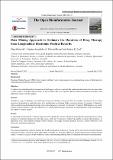Files in this item
Data mining approach to estimate the duration of drug therapy from longitudinal electronic medical records
Item metadata
| dc.contributor.author | Montvida, Olga | |
| dc.contributor.author | Arandelovic, Ognjen | |
| dc.contributor.author | Reiner, Edward | |
| dc.contributor.author | Paul, Sanjoy K. | |
| dc.date.accessioned | 2017-08-28T13:30:06Z | |
| dc.date.available | 2017-08-28T13:30:06Z | |
| dc.date.issued | 2017 | |
| dc.identifier | 250098892 | |
| dc.identifier | c6963b37-4879-402f-8338-40c48a841cb5 | |
| dc.identifier | 85030775986 | |
| dc.identifier.citation | Montvida , O , Arandelovic , O , Reiner , E & Paul , S K 2017 , ' Data mining approach to estimate the duration of drug therapy from longitudinal electronic medical records ' , Open Bioinformatics Journal , vol. 10 . https://doi.org/10.2174/1875036201709010001 | en |
| dc.identifier.issn | 1875-0362 | |
| dc.identifier.uri | https://hdl.handle.net/10023/11555 | |
| dc.description.abstract | Background: Electronic Medical Records (EMRs) from primary/ ambulatory care systems present a new and promising source of information for conducting clinical and translational research. Objectives: To address the methodological and computational challenges in order to extract reliable medication information from raw data which is often complex, incomplete and erroneous. To assess whether the use of specific chaining fields of medication information may additionally improve the data quality. Methods: Guided by a range of challenges associated with missing and internally inconsistent data, we introduce two methods for the robust extraction of patient-level medication data. First method relies on chaining fields to estimate duration of treatment (“chaining”), while second disregards chaining fields and relies on the chronology of records (“continuous”). Centricity EMR database was used to estimate treatment duration with both methods for two widely prescribed drugs among type 2 diabetes patients: insulin and glucagon-like peptide-1 receptor agonists. Results: At individual patient level the “chaining” approach could identify the treatment alterations longitudinally and produced more robust estimates of treatment duration for individual drugs, while the “continuous” method was unable to capture that dynamics. At population level, both methods produced similar estimates of average treatment duration, however, notable differences were observed at individual-patient level. Conclusion: The proposed algorithms explicitly identify and handle longitudinal erroneous or missing entries and estimate treatment duration with specific drug(s) of interest, which makes them a valuable tool for future EMR based clinical and pharmaco-epidemiological studies. To improve accuracy of real-world based studies, implementing chaining fields of medication information is recommended. | |
| dc.format.extent | 15 | |
| dc.format.extent | 446377 | |
| dc.language.iso | eng | |
| dc.relation.ispartof | Open Bioinformatics Journal | en |
| dc.subject | Electronic medical records | en |
| dc.subject | Treatment duration | en |
| dc.subject | Data mining | en |
| dc.subject | Type 2 diabetes | en |
| dc.subject | Rule-based algorithm | en |
| dc.subject | Patient-level data aggregation | en |
| dc.subject | QA75 Electronic computers. Computer science | en |
| dc.subject | RM Therapeutics. Pharmacology | en |
| dc.subject | NDAS | en |
| dc.subject | SDG 3 - Good Health and Well-being | en |
| dc.subject.lcc | QA75 | en |
| dc.subject.lcc | RM | en |
| dc.title | Data mining approach to estimate the duration of drug therapy from longitudinal electronic medical records | en |
| dc.type | Journal article | en |
| dc.contributor.institution | University of St Andrews. School of Computer Science | en |
| dc.identifier.doi | https://doi.org/10.2174/1875036201709010001 | |
| dc.description.status | Peer reviewed | en |
This item appears in the following Collection(s)
Items in the St Andrews Research Repository are protected by copyright, with all rights reserved, unless otherwise indicated.

